Cane and Bamboo Crafts of Manipur
- Part 2-
By: Mutua Bahadur *
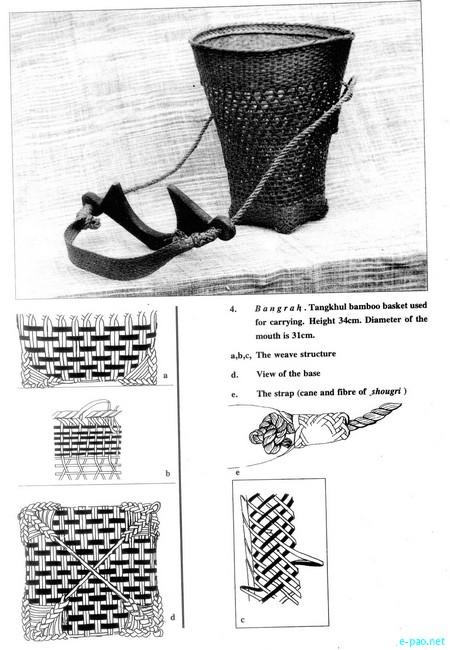
CULTURE
One cannot imagine the cultural life of the people living in the valley and in the hills of Manipur without bamboos and their products. Bamboo plants are related to a person's life, in one way or the other, even in death. There can be no end to the uses and utility of bamboo. Meiteis living in the valley differentiate particular varieties of bamboo according to their different uses: bamboo for use in rituals; bamboo for use in the daily lives of the people; bamboo for burning rubbish and the like, and so on.
The variety of bamboo that has no practical use is traditionally kept out by the society from amongst the pack of usable bamboo. Such a variety is the Wareng variety. The Wareng bamboo grows out of the fruits that fall to the ground from the Utang bamboo (Bambusa pallida).
It is believed that a family living in a house built without any bamboo can never be a happy one. For the Meiteis, if one is to start a home then there should be a bamboo grove growing on his plot of land. The growth of a bamboo grove is believed to foretell the fortune of a family. For this reason, bamboos are planted by the elders of the family, and never by the youths. It is believed that if a youth plants a bamboo seedling, his life-span will be curtailed.
Again, it is believed that if a bamboo flowers, then it is a bad omen for the head of the family owning that particular bamboo grove. For the villagers of Leimram, however, the flowering of bamboo is believed to bring good fortune if proper rituals are performed. Naturally enough, the villagers clamour for the flowers. When a bamboo flowers, some people take a portion of that bamboo and put it in the curry that is being prepared for the family's meal. When partaking the curry, one remarks: 'O, Bamboo : As you flower thus, let me who am partaking you as food bear the fruits'. This is supposed to bring good fortune to the person eating the food.
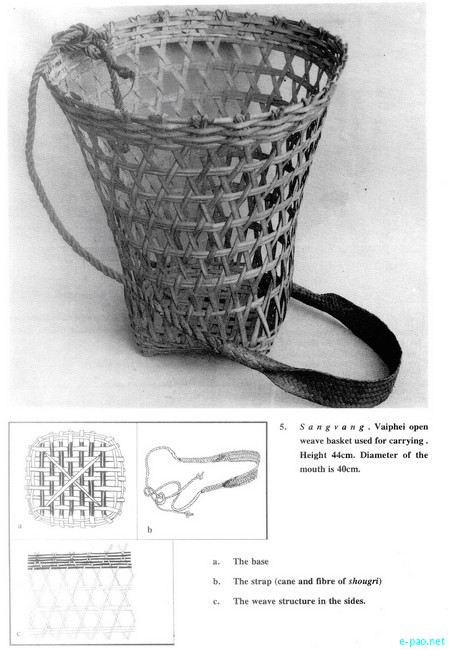
Meiteis pluck the tender leaves of the bamboo on Cheiraoba, the Meitei New Year's Day (celebrated in April), and add them to a dish called 'Utee'. This is believed to prevent the bamboo from flowering. Besides, eating such a dish is good for a family - to avoid a dark fate. However, the dish is not taken by the males. If and when there is a 'full' cluster of leaves and tiny branches on the tip of a bamboo plant, it is regarded as an ill-omen for the owner of that bamboo grove, since such type of bamboo resembles the Chanduwa bamboo used in the funeral pyre.
The bamboo that flowers is never used in the construction of houses. But in the case of twin bamboo plants in the grove, it is believed that the family owning that grove is blessed with good fortune, if a new-sprung bamboo grows up much more higher than the rest of the older plants, it is believed that the particular year shall be a happy one for the family owning that grove.
Bamboo with nodes are thought to be just like human beings, by the Meiteis. Bamboo are imagined to 'sleep' as humans do and, hence, the bamboos that are incorporated into the framework of the house are taken as 'sleeping' (inside the house as the humans do). When a bamboo grows up, the length of the inter-nodes is generally uniform. If it so happens that there is an irregularity in the length of the inter-nodes, e.g. if the length between two certain nodes happens to be quite short, then it is regarded as something bad to use that particular bamboo as Urep or main pillar of the house.
The reason is that since the said bamboo is being 'handicapped'in its growth due to some fault in it, a person using such a bamboo is believed to become one with the bamboo and, therefore, is liable to experience deformity in his body. The occurance of two nodes growing quite near to each other in the stem of a bamboo plant, is referred to as 'Shabou Lonba*.
In earlier times, midwives (usually Maibis) used to cut the umbilical cord of new-born babies with Waakthou made from the Utang bamboo. The reason for cutting the umbilical cord with the Waakthou is mainly due to a belief that just as a bamboo grows up gradually in uniformity, so may the tender child grow up healthily in uniform stages. Paya or fine bamboo splits made from the Utang bamboo are preferred to those made from the other varieties for binding the Khayom (offerings packed up in a bundle) in rituals.
It is customary to construct the Phampak or shrine of Sanamahi, the household deity of the Meiteis, with the Utang bamboo. It is prohibited to construct it with any other variety of bamboo. In the Clan Ancestors' Worship, the top portion of the scaffold from which holy water is poured over the deities, is constructed with the Utang bamboo, and not with any other variety.
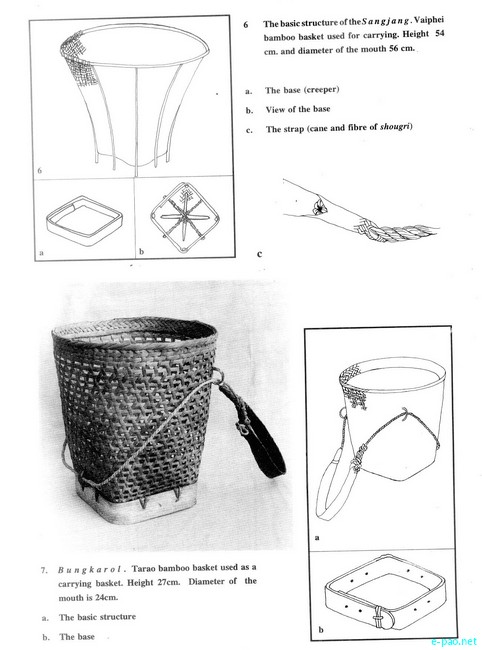
A notable custom of the Meiteis is the use of paya as waist-belt, tied over the phanek, by the women when they go out to attend a funeral. The two ends of the paya are tied in a knot, which is placed on the front of the body. The paya is tied in such a way that the two protruding ends of the knot point upwards. This seems to be a tradition that has been handed down the generations. After the funeral is over, the paya is unknotted and the tongue is cleaned with it. Then it is cast into the fire. Thereafter, the women sanctify themselves by dipping in the water and return home. The underlying belief is that these processes keep away evil spirits and prevent death from occuring twice in that particular family.
Meiteis observe a community ritual, known as Sharoi Khangba, on the first Saturday of the Lamta (March-April) month every year. 'Sharoi' implies 'evil spirits' and 'khangba' implies the ritual of making offerings to the Sharois so that the evil spirits do not cast their spells on that community. This ritual is performed by the women in each and every locality of the community. The women performing this ritual tie paya as waist-belt over the phanek they wear. When the ritual is over, the paya is removed and is used as a tongue-cleaner to clean the tongue; after which it is thrown down on the spot. The belief is that the act shall ward off the evil spirits from that particular locality.
At Andro, Laphu Chanang or pulpy 'flesh' of the banana stem are wrapped around five bamboo pieces and then burnt on fire. The bamboo pieces, charred with impressions of the burnt Laphu Chanang, are then pegged down on the graves of bachelors, and Huigangs are hung on them as a sign to let the people know that the particular grave is of a bachelor. If ropes made from the Utang bamboo are used for tethering cows, it is taken for granted that the cows shall gradually lose their strength.
In the case of a cow suffering from pain in its leg, a piece of Utang bamboo is cut and a lid is provided on the open end of the cut bamboo piece or tube. The belief is that if a dead house-lizard is put inside the bamboo tube and tied on the neck of the cow, then the cow shall be cured of the pain. 'Barren' cows are enabled to give birth if fed with the leaves of the Utang bamboo.
In the case of a dog-bite, it is believed that if the new leaves of the Utang bamboo are pounded into paste and applied to the wound, the 'medicine' sucks out the infectious poison injected into the body from the dog's bite. Yet in some other places, it is believed that after scraping off the outer layer or skin of an Utang bamboo tube, and after pouring water into it, if gently pressed on to the bitten part, the person shall be cured of the dog-bite. If a dog is subjected to Huigang thangba with Utang bamboo, it is assumed that the dog is bound to die. Huigang thangba is the practice of tying a rope around the neck of a dog, and then attaching a hollow bamboo tube to the rope by letting the rope flow through the tube.
It is believed that brushing teeth with Utang-paya curtails the life-span of the teeth. An interesting custom of the Meiteis is the bathing, of children, who are recovering from an illness due to venturing out-doors with water in which leaves of the Utang bamboo have been boiled. This is done on the seventh day after a child's recovery. The custom is still in practice today.
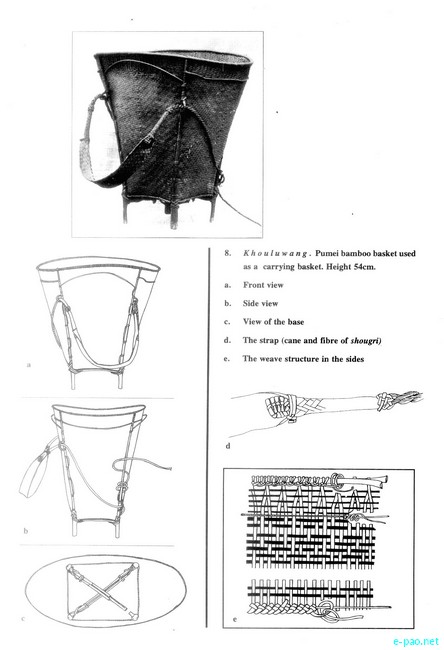
The Utang bamboo is also profusely used by people who practise Black-magic. The Utang bamboo is believed to be an incarnation of the Gods. Bards sing to glorify this belief:
The Creator, Guru Shidaba, after getting His two sons to create this World, thought of testing them to see which of them could perceive Him as the Father. Assuming the form of a cow, He floated down the river Awang Chaokhong Hiden. The two sons dragged It up and enquired of their Mother about It. After being informed by Ima Leimaren that It was the Guru, they used up the various parts of the cow to create several things. Thus, the Utang bamboo was created from the nails of the cow.
The leaves of the Uwil bamboo, when boiled in water and utilised by women with 'impure* blood, are supposed to 'purify' the blood. Again, if the water contained in the bamboo stem is used as hair oil, it is supposed to be very good for the hair. It is written in the ancient manuscripts that the Goddess Panthoibi was very fond of using the water obtained from the bamboo.
The Meiteis living in the valley used sacred fire in the worship of the Gods. The sacred fire is obtained from the Meiribop (Dendrocalamus hamiltonii) bamboo. The Meiribop (Meiri=flame) bamboo is so named because it is believed to emit flames. Just as the Hindu Meiteis sanctify themselves by sprinkling water on the body with Tulsi plants dipped in water, the Chakpas of Andro sanctify themselves with Khoiju (the scrapped off pulpy chips of the bamboo) dipped in water.
The Royal Chronicles mention that from very early times onwards, Kings, Queens, and Noblemen used to go out to eat Utong-chak (i.e. rice cooked in bamboo tubes). Bamboo tubes, about 60 cm. long, cut from a very small variety of bamboo, are stuffed with cleaned rice, and after providing a lid on the open end of the bamboo tube, it is grilled on fire. The burnt or charred outer layer is first removed completely. Thereafter, the cooked rice contained within is eaten by peeling off the pulpy layer of the bamboo. The best variety of bamboo for preparing Utong-chak is the Pokshang (Cephalostachyum pergracile) variety.
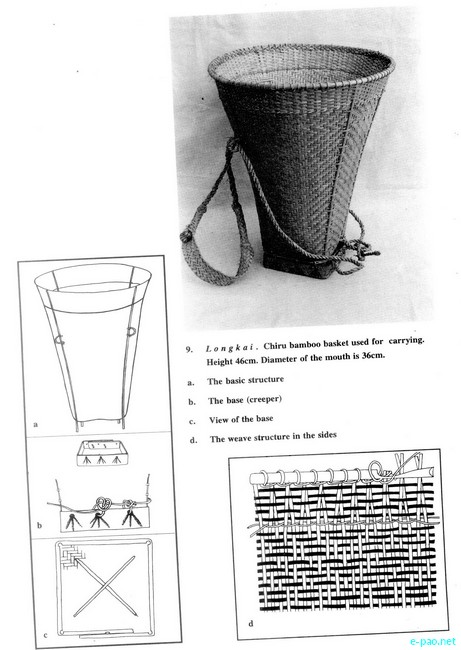
The new bamboo shoot is known as Ushoi by the Meiteis. The Ushoi is finely sliced and prepared as curry. Another variety of food obtained from the bamboo is the Shoibum or fermented sliced bamboo shoots. This provides one of the popular dishes of the Meiteis. The tender shoots of a very small variety of bamboo are chopped into pieces and then fermented to provide a food called 'Shoidon'.
The utility of bamboo extends over a much wider range, as is evident from its use in sports and games. From time immemorial, Meiteis used Kangjei or polo-sticks made from bamboo stems and Kangdrum or polo-balls made from bamboo roots as equipments for the game, 'Mukna-Kangjei'.
See a gallery photo of Cane and Bamboo Crafts of Manipur here.
To be continued ....
|
* Mutua Bahadur contributes to e-pao.net regularly. This article was webcasted on July 12, 2011.
* Comments posted by users in this discussion thread and other parts of this site are opinions of the individuals posting them (whose user ID is displayed alongside) and not the views of e-pao.net. We strongly recommend that users exercise responsibility, sensitivity and caution over language while writing your opinions which will be seen and read by other users. Please read a complete Guideline on using comments on this website.









